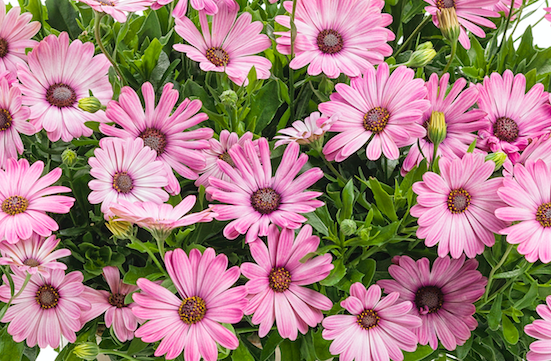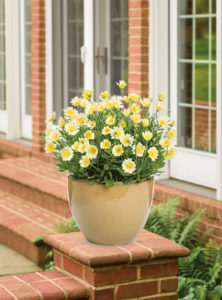
Culture Report: Osteospermum Bright Lights Series
The Bright Lights collection of osteospermum is focused on the pursuit of heat tolerance and improved habit that only the newer breeding of this genus offers. The collection containers six colors: Yellow, Pink, Double Moonglow and (new in 2019) White, Berry Rose and Purple. As with all of our collections the selection process is both consumer and grower based — focusing on extending the season and range of the crop, as well as selecting grower level characteristics such as habit, early blooming times and ease of production.

Osteospermum come from South Africa originally, and, contrary to what you might think, this does not mean they came from hot, steamy jungles. In fact, it is just the opposite in that South Africa is a land of desert to Mediterranean climates, mostly dry with very definite seasons determined by rainfall and temperature changes.
Osteospermum are naturally a spring flower in South Africa, so they bloom as temperatures begin to warm after a cold, but not freezing, winter. Most osteospermum can tolerate temperatures in the high 30s Fahrenheit with no problems at all.
In fact, low temperature is a great tool for controlling the crop. If you grow using DIF; a negative DIF can be very helpful in keeping the crop compact. Like most crops, remembering where they originally came from can help you to provide the best environment possible when they enter your nursery.
COOLER AND DRIER IS BETTER
Even with advancements in heat tolerance, Bright Lights osteospermum will shape up into a better crop if you keep temperatures cool and humidity low with good air circulation. So, this crop is ideally suited for early production for all growers; as the season moves into spring and summer the best crops will be those grown where temperatures can be kept lower.
High humidity is not good for osteospermum; if you find yourself trying to grow this crop alongside warm temperature/high humidity preference crops like coleus and ornamental sweet potato you are likely to have a lower quality crop. The higher temperatures and humidity promote stem and flower stretch, which in turn increases the need for plant growth regulators. Keep temperatures and humidity low for disease prevention, more compact plants and increased flower count. Watch your watering as well — osteospermum like to dry a bit between watering, so keep a close watch on soil moisture.
BRIGHT LIGHTS PREFER BRIGHT LIGHT
High light intensity is also required for high-quality osteospermum crops — again think of where the crop came from in high desert light conditions. So, when planning crop placement in your greenhouse make sure to keep Bright Lights osteospermum in the brightest light possible. The high light intensity gives you some key advantages. High light intensity will increase branching, help keep plants compact (reducing both stem and flower stem, or peduncle, length), and increase the bud or flower count.
TEMPERATURE MANAGEMENT
A couple temperature tips, if you have the ability to refine your temperatures by zone within the greenhouse:
During establishment, after transplanting the liners into their final containers, it can be helpful to run either the greenhouse or simply the root zone a bit warmer to speed and aid in rooting in. Raising root zone temperature to 65 to 70° F can speed the crop and get things off to a stronger start. After one week it is no longer needed, also if you have under bench heating it is usually not necessary.
Night temperatures below 50° F are key to uniform flowering and optimal flower and bud counts. Generally, we do not find vernalization is necessary for the Bright Lights collection; however, if you have the season, and/or controls, to provide the cool night temperatures it can only help in producing the highest quality crops.
Bringing the intense colors of Bright Lights osteospermum into your production cycle is simple; think about early spring production times, and, depending on your climate, the cool nights of late summer into autumn can make fall crops a possibility as well. If you want to speed the crop up and reduce the time and labor in your greenhouse, consider ordering in prefinished liners so that your job is easier and the crop moves even faster across your benches. Ask your salesperson for
more information.
Once you work out the window of the season that is best for your production, growing Bright Lights could not be simpler. They are tough and resilient plants; once established they do not require much water and remain in bloom throughout the spring and into summer. They have an extended retail shelf life, and their additional heat tolerance provides gardeners with a longer lasting and colorful investment in their garden!
CULTURE GUIDELINES
pH: 5.8 to 6.2
EC: 0.6 to 0.9
Fertilization: 150 to 200 ppm
Light Requirements: High
Water Categories: Dry to Moderate
Rooting Out Temperature: 65 to 72° F
Growing on Temperature: 55 to 65° F
Holding Temperature: 40 to 50° F
Finishing Times: 4- to 5-inch and quart pot: four to six weeks; 6-inch and gallon pot: five to seven weeks; 7- to 9-inch pot: seven to nine weeks; 10- to 12-inch and 2-gallon pot: 10 to 12 weeks
Pinching and Growth Regulators: No pinch necessary. PGRs should not be needed, but 5- to 10-ppm Sumagic is effective if needed.
Pest and Disease Management: Watch for Pythium, Phytophthora and Botrytis. Maintaining proper pH, avoiding overwatering especially early in crop cycle and maintaining good air circulation throughout production are the best preventative measures.
Grower Tip: Vernalization is not necessary for flowering.


 Video Library
Video Library 




















